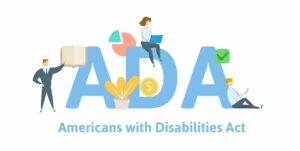A common question many employers face is, “how do we respond to a workplace accommodation request under the Americans with Disabilities Act (ADA)?” Like many legal questions, the answer starts with “it depends …”
Simply put, employers responding to accommodation requests must navigate a host of legal issues, including understanding the coverage of the ADA, how the ADA defines key terms like “disability” and “undue hardship”, and knowing how to engage in the necessary “interactive process” to address the request. Notably, the failure to properly respond to an ADA accommodation request can lead to significant legal exposure for an employer, particularly if the employment relationship ends. Successful plaintiffs under the ADA can recover not only back and front pay, but also compensatory and punitive damages and attorney’s fees.
The following are a few key points to consider when addressing an ADA accommodation request.
The Request
Broadly speaking, a reasonable accommodation is a modification to the work environment that an employer can reasonably implement that would allow an employee with a disability to perform the essential functions of a job, or enjoy benefits and privileges of employment that are enjoyed by similarly situated, non-disabled employees.
There is no specific form, or question, or magic phrase that an employee has to use to request an accommodation under the ADA. An employee may request a reasonable accommodation orally or in writing, at any time, and is not even required to have a particular accommodation in mind before making the request. Generally, all that is required is that the employer knows or has reason to know that the employee has a disability and a need for an accommodation.
Is the employer covered by the ADA or an analogous statute?
After receiving a request, the employer must consider whether it is covered by the ADA or an analogous state or local statute. With limited exceptions, a private employer is covered under the ADA if it has 15 or more employees on its payroll. Notably, however, state and local statutes often have narrower coverage provisions, but also prohibit discrimination based upon disability. For example, the Pennsylvania Human Relations Act applies to Pennsylvania businesses with 4 or more employees, while the Philadelphia Fair Practices Ordinance narrows the coverage to employers with 1 or more employees. Therefore, knowledge of the applicable law is essential to determining what action by the employer is required.
Does the employee have a “disability” protected by the ADA?
The ADA broadly defines disability as “a physical or mental impairment that substantially limits one or more major life activities of an individual (that is, an actual disability)” or “a record of this kind of impairment”. 42 U.S.C. § 12102(1).[1] A physical impairment includes any physiological disorder or condition, cosmetic disfigurement, or anatomical loss affecting one or more body systems (e.g. neurological, musculoskeletal, respiratory, etc.) A mental impairment includes a mental or psychological disorder, such as an intellectual disability or emotional or mental illness. 29 C.F.R. § 1630.2(h)(1), (2). “Major life activities” include seeing, hearing, sitting, standing, walking, lifting, bending, sleeping, breathing, thinking, and many more. 29 C.F.R. § 1630.2(i)(1)(i). Notably, the “record of impairment” definition of disability extends ADA protections to individuals who have a history of, or who have been misclassified as having, a physical or mental impairment. 29 C.F.R. § 1630.2(k)(3)).
One of the most difficult aspects of defining a disability is the meaning of the phrase “substantially limits”. While there is no clear definition in the ADA, the ADA Amendments Act of 2008 (ADAAA) and its regulations provide guidance on this issue. Per these regulations, employers are to construe “substantially limits” broadly. To qualify as a substantially limiting impairment, the impairment need not prevent, or significantly or severely restrict the individual from performing a major life activity. Employers are to judge the ability of the individual compared to most people in the general population, and without consideration of most mitigating measures, such as hearing aids. 29 C.F.R. § 1630.2(j)(1)(i)-(ix).
Is the employee “qualified”?
The purpose of an accommodation request is to allow the requesting employee to perform certain job duties, either in their current role or in a position they are seeking. Therefore, the individual making the request must be “qualified”, meaning the employee is able to perform the essential functions of the job with or without a reasonable accommodation, and otherwise has the skills, experience, etc. necessary for the position. Essential functions are “fundamental job duties of the employment position the individual with a disability holds or desires”. 29 C.F.R. § 1630.2(n)(1)).
“Undue Hardship” and “Direct Threat”
An employer is not required to make an accommodation if the accommodation would impose an undue hardship on the employer. This is a case-by-case determination, however the factors that determine undue hardship include: the nature and net cost of the accommodation, the overall financial resources of the employer, and the number of employees of the employer. 42 U.S.C. § 12111(10)(B).
In addition, certain disabilities can be considered to create a “direct threat” to the health or safety of others, which no reasonable accommodation can negate. 29 C.F.R. § 1630.2(r). For example, an employer may not be required to accommodate an individual who suffers from dizziness or fainting spells if the only jobs available require operation of heavy machinery, since the condition could endanger the workplace.
The Interactive Process
Assuming the proper criteria are met, the next step is for the employer and employee to engage in an “interactive process”. This is an area where difficulties often arise, as this process imposes duties on both the employer and the employee. As stated by the Third Circuit Court of Appeals in Taylor v. Phoenixville Sch. Dist., 184 F.3d 296, 312 (3d Cir. 1999), employers and employees “have a duty to assist in the search for appropriate reasonable accommodation and to act in good faith.” This means that both the employee and employer must engage in an “interactive process” “to work toward finding a suitable accommodation.” Id. Employers can show their good faith compliance in a number of ways, such as: “meeting with the employee who requests an accommodation, requesting information about the condition and what limitations the employee has, asking the employee what he or she specifically wants, showing some sign of having considered the employee’s request, and offering and discussing available alternatives when the request is too burdensome.” Id. at 317.
Importantly, if an accommodation is offered and it is reasonable, the employer has satisfied its obligations, even if the proposed accommodation is not the preferred choice of the employee. See, Khoury v. Secretary United States Army, 677 Fed.Appx. 735 (3d Cir. Jan. 27, 2017) (employee is not entitled to her preferred accommodation, only a reasonable one); Diaz v. City of Philadelphia, 565 Fed.Appx. 102, 106 (3d Cir. May 2, 2014) (“The ADA does not … require an employer to provide a disabled employee with the accommodation of her choosing.”)
Examples of Accommodations
Since accommodations are judged under a “reasonableness” standard, accommodations can be as unique as the person requesting them. However, common examples of reasonable accommodations include:
- physical changes such as installing a ramp or changing a workspace layout;
- accessible or assistive technologies such as reader software;
- accessible communications such as closed captioning at meetings;
- light-duty for certain physical demands of a job;
- modifications of work schedules;
- telecommuting; and,
- job reassignment.
For individuals with a “record of” disability, common accommodation examples include a schedule change or time off for medical follow-up or monitoring appointments with their physician.
Employer compliance: the bottom line
ADA compliance is a process. Training of management and maintaining clear and up-to-date employment policies are critical to properly responding to an accommodation request. Equally important is engaging in meaningful communications with any employee who requests an accommodation, as every situation is unique. Ultimately, the proper handling of accommodation requests requires not only active participation, monitoring and documentation, but also an understanding of this constantly evolving area of the law.
[1] The ADA definition of disability also includes “being regarded as” disabled. Individuals “regarded as” disabled are protected from discrimination under the ADA, however they are not entitled to a reasonable accommodation.
Jeffrey P. Burke, an associate in MacElree Harvey’s West Chester office, counsels businesses and individuals on employment agreements, equal employment policies, non-competition agreements, independent contracting issues, and other employment-related matters. Jeff also represents businesses and individuals in employment discrimination litigation, such as Americans with Disability Act claims, Age Discrimination in Employment Act claims, discrimination based upon sex, race or religion, sexual harassment, and hostile work environment.
To schedule a consultation with Jeff, call (610) 840-0229 or email [email protected].



